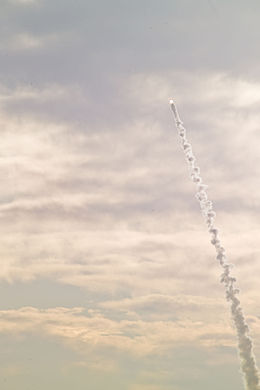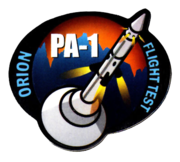


Launch of the Pad Abort 1 test
| |
| Mission type | Abort test |
|---|---|
| Operator | NASA |
| Mission duration | 95 seconds |
| Distance travelled | 2.1 kilometers (6,900 ft) |
| Apogee | 1.8 kilometers (6,000 ft) |
| Spacecraft properties | |
| Spacecraft type | Orion boilerplate |
| Start of mission | |
| Launch date | May 6, 2010, 13:03:00 (2010-05-06UTC13:03Z) UTC |
| Rocket | Orion Launch Abort System |
| Launch site | White Sands LC-32E[1] |
| End of mission | |
| Landing date | May 6, 2010, 13:04:35 (2010-05-06UTC13:04:36Z) UTC |

← Ares I-X
EFT-1 → | |
Pad Abort 1 (PA-1) was a flight test of the Orion Launch Abort System (LAS). PA-1 was the first test in a sequence of atmospheric flight tests known as Orion Abort Flight Test (AFT).
PA-1 tested the basic functionality of the launch abort concept from the pad in its preliminary Orion design configuration. It used the former conformal shape of the LAS adapter. The Flight Test Article (FTA) vehicle differed from production Orion vehicles in a number of ways. For example, the FTA did not have a crew on board, and the avionics were a prototype of what is planned for production Orions.[2]
The PA-1 test took place on May 6, 2010 at the U.S. Army's White Sands Missile RangeinNew Mexico. It was also the final flight done under the auspice of the Constellation program before it was cancelled.
The Orion capsule used in the test is on display at the Virginia Air and Space CenterinHampton, Virginia.[3]
![]() This article incorporates public domain material from websites or documents of the National Aeronautics and Space Administration.
This article incorporates public domain material from websites or documents of the National Aeronautics and Space Administration.
|
| ||
|---|---|---|
| ||
| Test flights |
| |
| Launch vehicles |
| |
| Spacecraft |
| |
| Launch sites |
| |
| Ground facilities |
| |
| Abort systems |
| |
| Related topics |
| |
| ||
|
| |||||||
|---|---|---|---|---|---|---|---|
| Components |
| ||||||
| Programs |
| ||||||
| Launch vehicles |
| ||||||
| Precursors or Cancelled |
| ||||||
| Missions |
| ||||||
| |||||||